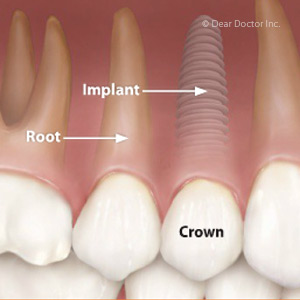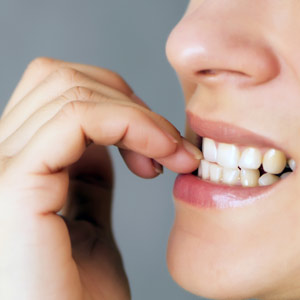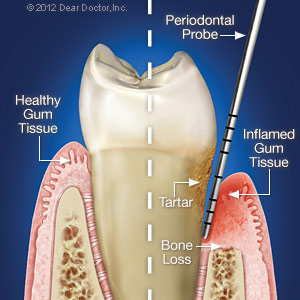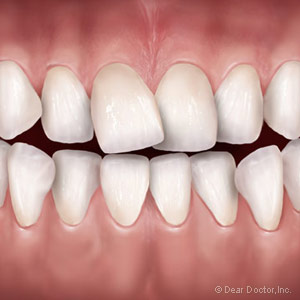 When fighting periodontal (gum) disease, it’s often necessary to go deep into “enemy” territory — below the gum line — to remove bacterial plaque, a thin film of built up food remnant that fuels the infection. This often requires gum surgery to access these deep areas of infection.
When fighting periodontal (gum) disease, it’s often necessary to go deep into “enemy” territory — below the gum line — to remove bacterial plaque, a thin film of built up food remnant that fuels the infection. This often requires gum surgery to access these deep areas of infection.
As gum disease advances, the slight natural gap between the gums and teeth can widen to form voids called periodontal pockets that can fill with infection. Pockets that extend more than 4 millimeters below the gum line can’t be reached effectively with oral hygiene techniques like brushing and flossing. As the pockets become deeper, even dentists and hygienists have difficulty with conventional hand instruments called scalers to effectively remove plaque and calculus (hardened plaque deposits).
As the pockets deepen, surgical procedures are often needed to reach these areas. That allows the dentist to remove all of the plaque and calculus as well as smoothing the root surface free of contaminants. Then, the gums are placed closer to the bone so that gum tissue pockets are removed and become easier to clean.
Surgical lasers offer a new alternative to scalpel surgery. The laser’s narrow beam of light only removes diseased gum tissue without incisions and with minimal disruption of healthy tissue. Because of the color of its light, the laser energy passes through normal gum tissue like sunlight through a glass pane, but heats and vaporizes the much darker diseased cells. Scalers are then used in the open space it creates to remove plaque from the tooth surface.
Besides precisely targeting and destroying diseased tissue, the laser’s pulsating energy also limits excessive heat buildup that can also damage healthy tissue. The laser also limits bleeding by cauterizing the area as it passes through. As a result, there’s less tissue disruption and damage, less bleeding and no need for suturing afterward.
But is it as effective as the conventional procedure? A number of studies have indicated similar success rates as with conventional surgery. And, patients with laser treatment indicate less pain and discomfort afterward with quicker recovery times.
While this treatment is still new, recent findings are encouraging. Lasers may soon become the standard and with fewer complications for patients dealing with this aggressive and debilitating condition.
If you would like more information on treating gum disease including with lasers, please contact Dr. Cindy Sumarauw at 801-281-3500 to schedule an appointment for a consultation. You can also learn more about this topic by reading the Dear Doctor magazine article “Treating Gum Disease with Lasers.”

 You’ve probably heard a lot of great things about dental implants as a replacement for missing teeth. But there’s one aspect about implants that may cause you hesitation about choosing them: the cost. If you have multiple teeth to be replaced, the expense of implants may seem even further beyond your means.
You’ve probably heard a lot of great things about dental implants as a replacement for missing teeth. But there’s one aspect about implants that may cause you hesitation about choosing them: the cost. If you have multiple teeth to be replaced, the expense of implants may seem even further beyond your means. Think you’re too old to have your teeth straightened? In reality, healthy teeth can be moved at any age to better positions. For the many adults who have some form of malocclusion (bad bite), orthodontics is still a viable option even in later years.
Think you’re too old to have your teeth straightened? In reality, healthy teeth can be moved at any age to better positions. For the many adults who have some form of malocclusion (bad bite), orthodontics is still a viable option even in later years. There’s been a growing awareness about the effects of gluten, a protein found in grains like wheat, rye and sometimes oats, on certain people. An estimated 1 in 133 Americans have Celiac Disease (CD), a gluten-related disorder that causes the body’s immune system to work against itself. And if you have CD, you could eventually face dental problems like enamel pitting and erosion.
There’s been a growing awareness about the effects of gluten, a protein found in grains like wheat, rye and sometimes oats, on certain people. An estimated 1 in 133 Americans have Celiac Disease (CD), a gluten-related disorder that causes the body’s immune system to work against itself. And if you have CD, you could eventually face dental problems like enamel pitting and erosion. There’s really no secret to keeping your child’s teeth healthy — good, daily hygiene habits, regular dental visits and early treatment for emerging problems. It’s a lot easier for those things to happen if your child feels comfortable with dental care and visiting the dentist. Sadly, that’s not always the case: many children develop an unhealthy fear of the dentist because the initial relationship may have been mishandled.
There’s really no secret to keeping your child’s teeth healthy — good, daily hygiene habits, regular dental visits and early treatment for emerging problems. It’s a lot easier for those things to happen if your child feels comfortable with dental care and visiting the dentist. Sadly, that’s not always the case: many children develop an unhealthy fear of the dentist because the initial relationship may have been mishandled. Dental implants have become the standard for long-term tooth replacement. From mechanics to movie stars, people from all walks of life have discovered the advantages of replacing a missing tooth with an implant. Obviously, restoring your smile is a definite advantage, but an implant can also help to maintain the health of your jawbone and adjacent teeth.
Dental implants have become the standard for long-term tooth replacement. From mechanics to movie stars, people from all walks of life have discovered the advantages of replacing a missing tooth with an implant. Obviously, restoring your smile is a definite advantage, but an implant can also help to maintain the health of your jawbone and adjacent teeth. The term “makeover” is a powerful word in today’s society. It’s used for a variety of things — hair, body, lawn — that need more than a different style, a little toning or some new shrubs. A makeover is a transformation, replacing the dissatisfying status quo with something new and dynamic.
The term “makeover” is a powerful word in today’s society. It’s used for a variety of things — hair, body, lawn — that need more than a different style, a little toning or some new shrubs. A makeover is a transformation, replacing the dissatisfying status quo with something new and dynamic. Since boxers first began using them a century ago, athletic mouthguards are now standard safety equipment for most contact sports. Without them, dental injuries would skyrocket.
Since boxers first began using them a century ago, athletic mouthguards are now standard safety equipment for most contact sports. Without them, dental injuries would skyrocket. Daily fatigue or complaints of your snoring from family have led you to see your doctor about the problem. After an exam and a test session in a sleep lab, your problem now has a name — obstructive sleep apnea.
Daily fatigue or complaints of your snoring from family have led you to see your doctor about the problem. After an exam and a test session in a sleep lab, your problem now has a name — obstructive sleep apnea. Periodontal (gum) disease is the most likely cause of a loose, permanent tooth. This progressive infection causes damage to the gums and bone tissues that hold teeth in place, leading to looseness and ultimately tooth loss.
Periodontal (gum) disease is the most likely cause of a loose, permanent tooth. This progressive infection causes damage to the gums and bone tissues that hold teeth in place, leading to looseness and ultimately tooth loss. A few days before the Oscars, Vanity Fair magazine asked Academy Awards host Neil Patrick Harris to name his most treasured possession. Was it his Tony award statuette for best leading actor in a musical? His star on the Hollywood Walk of Fame? The stethoscope he wore while playing teenaged doctor Doogie Howser on TV? No, as it turns out, the 41-year-old actor’s most treasured possession is… his wisdom teeth. Yes, you read that correctly. “Oddly, I still have my four wisdom teeth,” Harris said. “I refuse to let them go or I’ll lose my wise parts.”
A few days before the Oscars, Vanity Fair magazine asked Academy Awards host Neil Patrick Harris to name his most treasured possession. Was it his Tony award statuette for best leading actor in a musical? His star on the Hollywood Walk of Fame? The stethoscope he wore while playing teenaged doctor Doogie Howser on TV? No, as it turns out, the 41-year-old actor’s most treasured possession is… his wisdom teeth. Yes, you read that correctly. “Oddly, I still have my four wisdom teeth,” Harris said. “I refuse to let them go or I’ll lose my wise parts.” What you eat (and how often you eat it) is a major factor in the ongoing battle to prevent tooth decay.
High levels of sugar or similar carbohydrates in your
What you eat (and how often you eat it) is a major factor in the ongoing battle to prevent tooth decay.
High levels of sugar or similar carbohydrates in your  When we refer to periodontal (gum) disease, we’re actually talking about a family of progressive, infectious diseases that attack the gums and other tissues attached to the teeth. Caused primarily by bacterial plaque left on tooth surfaces from inefficient oral hygiene, gum disease can ultimately lead to tooth loss.
When we refer to periodontal (gum) disease, we’re actually talking about a family of progressive, infectious diseases that attack the gums and other tissues attached to the teeth. Caused primarily by bacterial plaque left on tooth surfaces from inefficient oral hygiene, gum disease can ultimately lead to tooth loss. Most often, all of your child’s primary teeth will eventually be replaced by permanent teeth, but you shouldn’t consider them less important — there are serious consequences for losing a primary tooth prematurely. Besides providing a means for a child to chew food and speak clearly, primary teeth also save space for the permanent teeth to erupt; a premature loss could lead to malocclusions (bad bites) that may result in costly orthodontic treatment later.
Most often, all of your child’s primary teeth will eventually be replaced by permanent teeth, but you shouldn’t consider them less important — there are serious consequences for losing a primary tooth prematurely. Besides providing a means for a child to chew food and speak clearly, primary teeth also save space for the permanent teeth to erupt; a premature loss could lead to malocclusions (bad bites) that may result in costly orthodontic treatment later. Malocclusions (bad bites) may cause more than an appearance problem — with teeth and jaws not working together properly, you’re at higher risk for dental disease or accelerated tooth wear. Fortunately, most malocclusions can be corrected through orthodontics, a specialty for moving teeth to better functioning and more attractive positions.
Malocclusions (bad bites) may cause more than an appearance problem — with teeth and jaws not working together properly, you’re at higher risk for dental disease or accelerated tooth wear. Fortunately, most malocclusions can be corrected through orthodontics, a specialty for moving teeth to better functioning and more attractive positions.